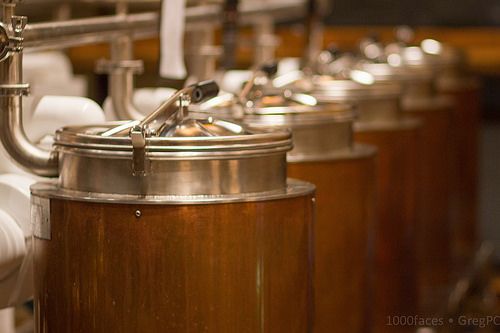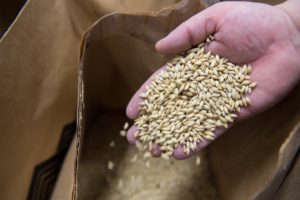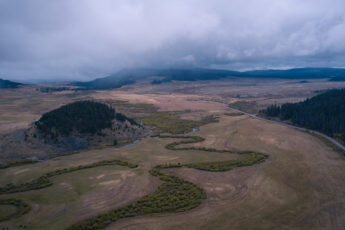
Every news outlet seems to be doing a story on Montana breweries right now.
New breweries are popping up in small towns across the state. A local brewery is nationally recognized for its positive impact on its neighborhood. Montana craft breweries are said to have a huge economic impact.
Surely, your Facebook feeds are as full of beer as ours are. But why are breweries getting so much attention? I mean, it’s just beer, right?
Not quite. It’s not just beer.
Montana’s cattle industry isn’t just about a 1,200-pound animal with dark eyes and a big tongue, nor is Montana’s craft beer industry just about crisp IPAs and four-dollar stouts. It’s about building strong communities, supporting our agricultural way of life, providing good-paying jobs, and protecting our clean water and open landscapes.
2 Basset Brewery costumers wetting their whistles in White Sulphur Springs (photo by Ben Goertzen).
Local breweries are just that — they’re local. They are gathering places where friends, families, and colleagues can meet and relax in a comfortable environment. They are community spaces where folks can hold and attend meetings or catch up on what’s happening around town.
Matt Leow, the executive director of the Montana Brewers Association, spoke to us about the role that a brewery owner can play in developing a community atmosphere.
“I mean if you just look at the people — the folks who are in this industry, who are driving this growth, who are starting breweries,” he said. “They’re community members. They are the people who are invested in their community.”
Brewery owners strive to create an environment that reflects their community’s values. They work to build a space that is appreciated and frequented by their friends and neighbors, and they make business decisions that will support the growth and success of their town.
“These are local businesses that aren’t going anywhere. Their identity is tied to the community,” Leow said.
Ruby Valley Brew is located right on Main Street in Sheridan.
Ruby Valley Brew is a major community meeting space for the rural Montana valley it calls home. After being opened for only five months, it has already become the social center of Sheridan.
“I really enjoy that space because it’s small, it’s quaint, it’s cozy.” said Amanda LaYacona, the owner of Ruby Valley Brew. They were aiming for “that Cheers-type atmosphere where everyone is welcome and it feels like home.”
They’ve got good aim; their shot was right on target. On just a regular Tuesday afternoon, there’s a cross-section of the whole community under one roof. There’s a family playing games at one table, a group of middle-aged women chatting at another, a few hunters walking in the door, and two ranchers talking at the bar next to a young couple.
The brewery is really what the community wanted, Amanda explained. “And you know it’s kind of turned into a social gathering place for folks… Young, middle aged, all kinds. It’s really a good blend of all sorts of people.”
Breweries can be a watering hole for our rural communities. They can also support these rural economies by purchasing Montana-grown products. It’s a no-brainer, really. What’s the best way to make a high-quality, brewed-in-Montana beer? Well, by using high-quality, grown-in-Montana ingredients.
Luckily for us, Montana was made for beer production. We’ve got the climate, the land, and the know-how to produce top-of-the-line hops and barley. And we’ve got the facilities to process those crops into ready-to-brew ingredients.
“We have great relationships with growers and with those industry associations that represent our local ag producers, and we want to support them,” said Leow. “Our members make an effort to purchase products locally and in some ways it’s not that difficult because Montana is a big barley-producing state.”
It’s true. Montana farmers can grow the heck out of some barley. According to an October article in Agweek, Montana is the nation’s top barley producer. Our farmers planted 700,000 acres of barley this year, which beat out North Dakota and Idaho.
Barley grows well in irrigated fields in rotation with sugar beets. It’s also a great alternative to dryland wheat. But barley isn’t the easiest crop to grow. It’s susceptible to scab, a disease that often comes from corn. Once infected, it can no longer be sold for malting and instead must be sold at a lower price for animal feed.
Despite the challenges, Montana growers are taking the risk, largely because there’s a new customer in town: craft brewers.
Before Montana’s craft beer industry took off, there were two main purchasers of malt barley: MillerCoors and Anheuser-Busch. Without much competition, those two companies had the power to set the prices. Now as more buyers enter into the market, farmers can negotiate a better price for their barley. They can also negotiate on which variety they grow. Montana Brewers Association is facilitating that conversation. It’s bringing together the growers, researchers, maltsters, and brewers so that people can choose their ideal barley varieties.
Growers want high yield and high quality. Maltsters want a barley with good extracting capabilities. And brewers want a barley that will have unique quality traits and a stable supply.
 Erik Somerfield of the Montana Farmers Union is a third-generation grower of malt barley. He spoke to brewers and industry folks this fall at the Montana Brewers Association Conference.
Erik Somerfield of the Montana Farmers Union is a third-generation grower of malt barley. He spoke to brewers and industry folks this fall at the Montana Brewers Association Conference.
For Erik, it’s simple: “Without me, you don’t make beer.”
He is interested in experimenting with growing different varieties for brewers. “I’ll grow whatever variety you want. As long as you pay me for it,” he said to a room of brewers.
Dr. Jamie Sherman, a barley breeder at Montana State University, was also at the conference. She and her team are doing research on over 600 varieties of heirloom barley to see which grows best in Montana and which works best for brewers and maltsters. They’re findings will help inform producers so they can stay competitive.
The other key ingredient to beer is hops — that beautiful flower that adds stability and flavor to beer. Hops also grows well in certain places in Montana, specifically in the Gallatin Valley and in the Flathead. Hops growers can either sell directly to the breweries or to a facility like Glacier Hops Ranch that processes the hops into pellets, oils, and extracts.
The Front Brewing Company (now Jeremiah Johnson Brewing Company) in Great Falls is one of the many local breweries that sees the value in sourcing Montana-grown ingredients. We spoke with Tristan Bradford, the brewing operations director, who said that a lot of their ingredients are sourced locally.
“These ingredients are right here in our backyard, and then we’re using them and turning them back to our Montana customers,” he said.
This Great Falls brewery sources all of its honey from Smoot Honey in Power. That honey is used in their renowned Mountain Man Scotch Ale as well as a honey wheat beer which won silver in the 2017 National Honey Beer Competition.
As for their malt, 90 percent of their beer is made with a base pale malt that uses Montana-grown barley and is malted right in Great Falls at Malteurop. Malteurop is one of the leading suppliers of malt and at least 47 other breweries in the state use its base pale malt, Bradford explained.
When breweries aren’t using Malteurop’s base pale malt to create their delicious brews, they’re using specialty malts from craft maltsters. Historically, these craft malts have come from out of state or from international sources. But thanks to a new company in Butte, they too can come from Montana. Montana Craft Malt is a 10,000 ton malting facility. It uses Montana-grown barley to produce a variety of specialty malts designed specifically for craft brewers.
Jeff Parks, the head maltster at Montana Craft Malt, also spoke at the Montana Brewers Association Fall Conference.
“The U.S. craft brewers are driving the barley bus,” he said.
It’s not the big breweries anymore. Craft brewers want unique flavors and Montana Craft Malt wants to give that to them here in our state, with a made-in-Montana malt, so they don’t have to look overseas.
The final ingredient, and arguably the most important, is water.
“Without clean water, you can’t make good beer,” said Leow, of the Montana Brewers Association. That makes sense, considering that beer is 90 to 95 percent water.
Montana is a state that values and treasures its clean water. Our craft brewers know what a precious resource they have, and they understand the role they must play in keeping this water pristine.
In a recent op-ed to the Great Falls Tribune, a handful of brewers from across Montana stated their support for the Clean Water Act.
“Montana’s pristine water resources help us craft world class beer and sustain our industry,” they wrote. “This is why we, as craft brewers, support protections for clean water, and oppose actions taken by the current administration to undermine the Clean Water Act.”
It doesn’t get much more Montana than that. They’ve practically taken a page right out of our state’s constitution: “The state and each person shall maintain and improve a clean and healthful environment in Montana for present and future generations.”
And isn’t that what it’s all really about? Isn’t that what we’re all shooting for? A comfortable, safe, stable, healthy environment for present and future generations? Our Montana craft breweries hold those same values.
We raise our glass to you.
Cheers to everyone who helps make a Montana-made beer we can all be proud of. May you have a clean and healthful environment for present and future generations.
-Amanda Garant
Updated on November 15, 2018 at 9am
Special thanks to Matt Leow of the Montana Brewers Association, Amanda LaYacona of Ruby Valley Brew, and Tristan Bradford of The Front Brewing Company (now Jeremiah Johnson Brewing Company) for taking the time to talk to us.
Got something to say to Prairie Populist? Send news tips, story ideas and comments to [email protected]. If you have something to submit, or an idea for a story you’d like to write for us, check out our Submission Guidelines here.


